Facile Microwave Hydrothermal Synthesis of ZnFe2O4/rGO Nanocomposites and Their Ultra-Fast Adsorption of Methylene Blue Dye
Abstract
:1. Introduction
2. Materials and Methods
2.1. Materials
2.2. Synthesis GO Powder
2.3. Synthesis of ZFG Nanoadsorbent
2.4. Characterizations
2.5. Dye Adsorption
3. Results and Discussion
3.1. Structural Characterization
3.1.1. XRD Analysis
3.1.2. Raman Spectrum
3.1.3. FTIR Spectrum
3.1.4. Magnetic Property
3.1.5. Morphological Characterization
3.1.6. N2 Adsorption–Desorption Measurement
3.2. Dye Adsorption Study
3.2.1. Effect of Contact Time
3.2.2. Adsorption Kinetic Study
3.2.3. Adsorption Isotherm Study
3.2.4. Effect of pH Values
3.2.5. Recycle Test
3.2.6. Adsorption Mechanism
4. Conclusions
Supplementary Materials
Author Contributions
Funding
Institutional Review Board Statement
Informed Consent Statement
Data Availability Statement
Conflicts of Interest
References
- Konicki, W.; Aleksandrzak, M.; Moszyński, D.; Mijowska, E. Adsorption of anionic azo-dyes from aqueous solutions onto graphene oxide: Equilibrium, kinetic and thermodynamic studies. J. Colloid Interface Sci. 2017, 496, 188–200. [Google Scholar] [CrossRef]
- Routoula, E.; Patwardhan, S.V. Degradation of anthraquinone dyes from effluents: A review focusing on enzymatic dye degradation with industrial potential. Environ. Sci. Technol. 2020, 54, 647–664. [Google Scholar] [CrossRef]
- Hussain, S.; Khan, N.; Gul, S.; Khan, S.; Khan, H. Contamination of water resources by food dyes and its removal technologies. In Water Chemistry; Eyvaz, M., Yüksel, E., Eds.; IntechOpen: London, UK, 2020; pp. 113–126. [Google Scholar]
- Vutskits, L.; Briner, A.; Klauser, P.; Gascon, E.; Dayer, A.G.; Kiss, J.Z.; Muller, D.; Licker, M.J.; Morel, D.R. Adverse effects of methylene blue on the central nervous system. Anesthesiology 2008, 108, 684–692. [Google Scholar] [CrossRef] [Green Version]
- Derakhshan, Z.; Baghapour, M.A.; Ranjbar, M.; Faramarzian, M. Adsorption of methylene blue dye from aqueous solutions by modified pumice stone: Kinetics and equilibrium studies. Health Scope 2013, 2, 136–144. [Google Scholar] [CrossRef] [Green Version]
- Albert, M.; Lessin, M.S.; Gilchrist, B.F. Methylene blue: Dangerous dye for neonates. J. Pediatr. Surg. 2003, 38, 1244–1245. [Google Scholar] [CrossRef]
- Qiao, X.Q.; Hu, F.C.; Tian, F.Y.; Hou, D.F.; Li, D.S. Equilibrium and kinetic studies on MB adsorption by ultrathin 2D MoS2 nanosheets. RSC Adv. 2016, 6, 11631–11636. [Google Scholar] [CrossRef]
- Rathee, G.; Awasthi, A.; Sood, D.; Tomar, R.; Tomar, V.; Chandra, R. A new biocompatible ternary layered double hydroxide adsorbent for ultrafast removal of anionic organic dyes. Sci. Rep. 2019, 9, 16225. [Google Scholar] [CrossRef] [PubMed] [Green Version]
- Pawar, P.R.; Bhosale, S.M. Heavy metal toxicity, health hazards and their removal technique by natural adsorbents: A short overview. Int. J. Curr. Eng. Technol. 2018, 8. [Google Scholar] [CrossRef] [Green Version]
- Chen, P.; Li, H.; Song, S.; Weng, X.; He, D.; Zhao, Y. Adsorption of dodecylamine hydrochloride on graphene oxide in water. Results Phys. 2017, 7, 2281–2288. [Google Scholar] [CrossRef]
- Kumar, P.S.; Varjani, S.J.; Suganya, S. Treatment of dye wastewater using an ultrasonic aided nanoparticle stacked activated carbon: Kinetic and isotherm modelling. Bioresour. Technol. 2018, 250, 716–722. [Google Scholar] [CrossRef] [PubMed]
- Wang, X.; Zhu, N.; Yin, B. Preparation of sludge-based activated carbon and its application in dye wastewater treatment. J. Hazard. Mater. 2008, 153, 22–27. [Google Scholar] [CrossRef]
- Ghaedi, M.; Nasab, A.G.; Khodadoust, S.; Rajabi, M.; Azizian, S. Application of activated carbon as adsorbents for efficient removal of methylene blue: Kinetics and equilibrium study. J. Ind. Eng. Chem. 2014, 20, 2317–2324. [Google Scholar] [CrossRef]
- Adeogun, A.I. Removal of methylene blue dye from aqueous solution using activated charcoal modified manganese ferrite (AC-MnFe2O4): Kinetics, isotherms, and thermodynamics studies. Part. Sci. Technol. 2020, 38, 756–767. [Google Scholar] [CrossRef]
- Hassan, M.M.; Carr, C.M. A critical review on recent advancements of the removal of reactive dyes from dyehouse effluent by ion-exchange adsorbents. Chemosphere 2018, 209, 201–219. [Google Scholar] [CrossRef]
- Khan, M.I.; Wu, L.; Mondal, A.N.; Ya, Z.; Ge, L.; Xu, T. Adsorption of methyl orange from aqueous solution on anion exchange membranes: Adsorption kinetics and equilibrium. Membr. Water Treat. 2016, 7, 23–38. [Google Scholar] [CrossRef]
- Khan, M.I.; Khan, M.A.; Zafar, S.; Ashiq, M.N.; Athar, M.; Qureshi, A.M.; Arshad, M. Kinetic, equilibrium and thermodynamic studies for the adsorption of methyl orange using new anion exchange membrane (BII). Desalination Water Treat. 2017, 58, 285–297. [Google Scholar] [CrossRef]
- Khan, M.A.; ALOthman, Z.A.; Naushad, M.; Khan, M.R.; Luqman, M. Adsorption of methylene blue on strongly basic anion exchange resin (Zerolit DMF): Kinetic, isotherm, and thermodynamic studies. Desalination Water Treat. 2015, 53, 515–523. [Google Scholar] [CrossRef]
- De Abreu Domingos, R.; da Fonseca, F.V. Evaluation of adsorbent and ion exchange resins for removal of organic matter from petroleum refinery wastewaters aiming to increase water reuse. J. Environ. Manag. 2018, 214, 362–369. [Google Scholar] [CrossRef]
- Geim, A.K.; Novoselov, K.S. The rise of graphene. Nat. Mater. 2007, 6, 183–191. [Google Scholar] [CrossRef]
- Yang, G.; Li, L.; Lee, W.B.; Ng, M.C. Structure of graphene and its disorders: A review. Sci. Technol. Adv. Mater. 2018, 19, 613–648. [Google Scholar] [CrossRef] [PubMed] [Green Version]
- Sur, U.K. Graphene: A rising star on the horizon of materials science. Int. J. Electrochem. 2012, 2012, 237689. [Google Scholar] [CrossRef]
- Sham, A.Y.W.; Notley, S.M. Adsorption of organic dyes from aqueous solutions using surfactant exfoliated graphene. J. Environ. Chem. Eng. 2018, 6, 495–504. [Google Scholar] [CrossRef] [Green Version]
- Zhang, X.; Qin, C.; Gong, Y.; Song, Y.; Zhang, G.; Chen, R.; Gao, Y.; Xiao, L.; Jia, S. Co-adsorption of an anionic dye in the presence of a cationic dye and a heavy metal ion by graphene oxide and photoreduced graphene oxide. RSC Adv. 2019, 9, 5313–5324. [Google Scholar] [CrossRef] [Green Version]
- Gupta, K.; Khatri, O.P. Reduced graphene oxide as an effective adsorbent for removal of malachite green dye: Plausible adsorption pathways. J. Colloid Interface Sci. 2017, 501, 11–21. [Google Scholar] [CrossRef] [PubMed]
- Xiao, J.; Lv, W.; Xie, Z.; Tan, Y.; Song, Y.; Zheng, Q. Environmentally friendly reduced graphene oxide as a broad-spectrum adsorbent for anionic and cationic dyes via π–π interactions. J. Mater. Chem. A 2016, 4, 12126–12135. [Google Scholar] [CrossRef]
- Gupta, A.; Viltres, H.; Gupta, N.K. Sono-adsorption of organic dyes onto CoFe2O4/Graphene oxide nanocomposite. Surf. Interfaces 2020, 20, 100563. [Google Scholar] [CrossRef]
- Gupta, K.; Komal, N.; Tikoo, K.B.; Kumar, V.; Bansal, S.; Kaushik, A.; Singhal, S. Synchronous role of coupled adsorption and photocatalytic oxidation on the hybrid nanomaterials of pectin and nickel ferrite leads to the excellent removal of toxic dye effluents. New J. Chem. 2020, 44, 18879–18891. [Google Scholar] [CrossRef]
- Li, Y.; Lu, H.; Wang, Y.; Zhao, Y.; Li, X. Efficient removal of methyl blue from aqueous solution by using poly(4-vinylpyridine)–graphene oxide-Fe3O4 magnetic nanocomposites. J. Mater. Sci. 2019, 54, 7603–7616. [Google Scholar] [CrossRef]
- Geng, Z.; Lin, Y.; Yu, X.; Shen, Q.; Ma, L.; Li, Z.; Pan, N.; Wang, X. Highly efficient dye adsorption and removal: A functional hybrid of reduced graphene oxide-Fe3O4 nanoparticles as an easily regenerative adsorbent. J. Mater. Chem. 2012, 22, 3527. [Google Scholar] [CrossRef]
- Saiphaneendra, B.; Saxena, T.; Singh, S.A.; Madras, G.; Srivastava, C. Synergistic effect of co-existence of hematite (α-Fe2O3) and magnetite (Fe3O4) nanoparticles on graphene sheet for dye adsorption. J. Environ. Chem. Eng. 2017, 5, 26–37. [Google Scholar] [CrossRef]
- Yang, G.; Park, S.J. Conventional and microwave hydrothermal synthesis and application of functional materials: A review. Materials 2019, 12, 1177. [Google Scholar] [CrossRef] [PubMed] [Green Version]
- Novais, S.M.V.; Silva, P.C.R.; Macedo, Z.S.; Barbosa, L.B. Short time and low temperature reaction between metal oxides through microwave-assisted hydrothermal method. Adv. Condens. Matter Phys. 2016, 2016, 3745459. [Google Scholar] [CrossRef] [Green Version]
- Ambrožič, G.; Orel, Z.C.; Žigon, M. Microwave-assisted non-aqueous synthesis of ZnO nanoparticles. Mater. Technol. 2011, 45, 173–177. [Google Scholar]
- Morsali, A.; Hashemi, L. Nanoscale coordination polymers: Preparation, function and application. In Advances in Inorganic Chemistry; van Eldik, R., Ruiz-Molina, D., Eds.; Elsevier: Amsterdam, The Netherlands, 2020; Volume 76, pp. 33–72. [Google Scholar]
- Amiri, M.; Gholami, T.; Amiri, O.; Pardakhti, A.; Ahmadi, M.; Akbari, A.; Amanatfard, A.; Salavati-Niasari, M. The magnetic inorganic-organic nanocomposite based on ZnFe2O4-Imatinib-liposome for biomedical applications, in vivo and in vitro study. J. Alloys Compd. 2020, 849, 156604. [Google Scholar] [CrossRef]
- Sabale, S.; Jadhav, V.; Khot, V.; Zhu, X.; Xin, M.; Chen, H. Superparamagnetic MFe2O4 (M = Ni, Co, Zn, Mn) nanoparticles: Synthesis, characterization, induction heating and cell viability studies for cancer hyperthermia applications. J. Mater. Sci. Mater. Med. 2015, 26, 127. [Google Scholar] [CrossRef] [PubMed]
- Rameshbabu, R.; Ramesh, R.; Kanagesan, S.; Karthigeyan, A.; Ponnusamy, S. Structural, morphological and magnetic properties of hydrothermally synthesized ZnFe2O4 nanoparticles. J. Mater. Sci. Mater. Electron. 2014, 25, 2583–2588. [Google Scholar] [CrossRef]
- Sadighian, S.; Abbasi, M.; Arjmandi, S.A.; Karami, H. Dye Removal from Water by Zinc Ferrite-graphene oxide Nanocomposite. Prog. Color Colorants Coat. 2018, 11, 85–92. [Google Scholar]
- Fei, P.; Qiao, J.; Huo, J.X.; Liu, J.H.; Zhong, M.; Su, B.T. Barium (II)-doped zinc ferrite-reduced graphene oxide nanohybrids for superior adsorption and magnetic properties. New Carbon Mater. 2017, 32, 402–410. [Google Scholar] [CrossRef]
- Wan, J.; Jiang, X.; Li, H.; Chen, K. Facile synthesis of zinc ferrite nanoparticles as non-lanthanide T1 MRI contrast agents. J. Mater. Chem. 2012, 22, 13500. [Google Scholar] [CrossRef]
- Lyubutin, I.S.; Baskakov, A.O.; Starchikov, S.S.; Shih, K.Y.; Lin, C.R.; Tseng, Y.T.; Yang, S.S.; Han, Z.Y.; Ogarkova, Y.L.; Nikolaichik, V.I.; et al. Synthesis and characterization of graphene modified by iron oxide nanoparticles. Mater. Chem. Phys. 2018, 219, 411–420. [Google Scholar] [CrossRef]
- Shih, K.Y.; Kuan, Y.L.; Wang, E.R. One-Step Microwave-Assisted Synthesis and Visible-Light Photocatalytic Activity Enhancement of BiOBr/RGO Nanocomposites for Degradation of Methylene Blue. Materials 2021, 14, 4577. [Google Scholar] [CrossRef]
- Hummers, W.S.; Offeman, R.E. Preparation of graphitic oxide. J. Am. Chem. Soc. 1958, 80, 1339. [Google Scholar] [CrossRef]
- Pareek, A.; Sravan, J.S.; Mohan, S.V. Graphene modified electrodes for bioelectricity generation in mediator-less microbial fuel cell. J. Mater. Sci. 2019, 54, 11604–11617. [Google Scholar] [CrossRef]
- Cao, N.; Zhang, Y. Study of reduced graphene oxide preparation by Hummers’ method and related characterization. J. Nanomater. 2015, 2015, 168125. [Google Scholar] [CrossRef] [Green Version]
- Yin, W.; Hao, S.; Cao, H. Solvothermal synthesis of magnetic CoFe2O4/rGO nanocomposites for highly efficient dye removal in wastewater. RSC Adv. 2017, 7, 4062–4069. [Google Scholar] [CrossRef] [Green Version]
- Zhu, S.; Jiao, S.; Liu, Z.; Pang, G.; Feng, S. High adsorption capacity for dye removal by CuZn hydroxyl double salts. Environ. Sci. Nano. 2014, 1, 172–180. [Google Scholar] [CrossRef]
- Maharana, H.S.; Rai, P.K.; Basu, A. Surface-mechanical and electrical properties of pulse electrodeposited Cu–graphene oxide composite coating for electrical contacts. J. Mater. Sci. 2016, 52, 1089–1105. [Google Scholar] [CrossRef]
- Gupta, B.; Kumar, N.; Panda, K.; Kanan, V.; Joshi, S.; Visoly-Fisher, I. Role of oxygen functional groups in reduced graphene oxide for lubrication. Sci. Rep. 2017, 7, 45030. [Google Scholar] [CrossRef] [PubMed]
- Liu, S.Q.; Zhu, X.L.; Zhou, Y.; Meng, Z.D.; Chen, Z.G.; Liu, C.B.; Chen, F.; Wu, Z.Y.; Qian, J.C. Smart photocatalytic removal of ammonia through molecular recognition of zinc ferrite/reduced graphene oxide hybrid catalyst under visible-light irradiation. Catal. Sci. Technol. 2017, 7, 3210–3219. [Google Scholar] [CrossRef]
- Rameshbabu, R.; Ramesh, R.; Kanagesan, S.; Karthigeyan, A.; Ponnusamy, S. Synthesis and study of structural, morphological and magnetic properties of ZnFe2O4 nanoparticles. J. Supercond. Nov. Magn. 2014, 27, 1499–1502. [Google Scholar] [CrossRef]
- Xia, H.; Qian, Y.; Fu, Y.; Wang, X. Graphene anchored with ZnFe2O4 nanoparticles as a high-capacity anode material for lithium-ion batteries. Solid State Sci. 2013, 17, 67–71. [Google Scholar] [CrossRef]
- Dong, Q.; Liu, X.; Zhang, W. Enhanced photogenerated charge separation in α-Fe2O3-ZnFe2O4 related to the higher level in the conduction band of α-Fe2O3. Opt. Mater. Express 2019, 9, 3519–3526. [Google Scholar] [CrossRef]
- Gurushantha, K.; Anantharaju, K.S.; Renuka, L.; Sharma, S.C.; Nagaswarupa, H.P.; Prashantha, S.C.; Vidya, Y.S.; Nagabhushana, H. New green synthesized reduced graphene oxide-ZrO2 composite as high performance photocatalyst under sunlight. RSC Adv. 2017, 7, 12690–12703. [Google Scholar] [CrossRef] [Green Version]
- Jiao, X.; Qiu, Y.; Zhang, L.; Zhang, X. Comparison of the characteristic properties of reduced graphene oxides synthesized from natural graphites with different graphitization degrees. RSC Adv. 2017, 7, 52337–52344. [Google Scholar] [CrossRef] [Green Version]
- Wu, J.B.; Lin, M.L.; Cong, X.; Liu, H.N.; Tan, P.H. Raman spectroscopy of graphene-based materials and its applications in related devices. Chem. Soc. Rev. 2018, 47, 1822–1873. [Google Scholar] [CrossRef] [Green Version]
- Mishra, A.; Singh, V.K.; Mohanty, T. Coexistence of interfacial stress and charge transfer in graphene oxide-based magnetic nanocomposites. J. Mater. Sci. 2017, 52, 7677–7687. [Google Scholar] [CrossRef]
- Hafeez, H.Y.; Lakhera, S.K.; Narayanan, N.; Harish, S.; Hayakawa, Y.; Lee, B.K.; Neppolian, B. Environmentally sustainable synthesis of a CoFe2O4-TiO2/rGO ternary photocatalyst: A highly efficient and stable photocatalyst for high production of hydrogen (solar fuel). ACS Omega 2019, 4, 880–891. [Google Scholar] [CrossRef] [Green Version]
- Luo, J.; Yan, Z.; Liu, R.; Xu, J.; Wang, X. Synthesis and excellent visible light photocatalysis performance of magnetic reduced graphene oxide/ZnO/ZnFe2O4 composites. RSC Adv. 2017, 7, 23246–23254. [Google Scholar] [CrossRef] [Green Version]
- Emiru, T.F.; Ayele, D.W. Controlled synthesis, characterization and reduction of graphene oxide: A convenient method for large scale production. Egypt. J. Basic Appl. Sci. 2016, 4, 74–79. [Google Scholar] [CrossRef] [Green Version]
- Rameshbabu, R.; Ramesh, R.; Kanagesan, S.; Karthigeyan, A.; Ponnusamy, S. One pot facile hydrothermal synthesis of superparamagnetic ZnFe2O4 nanoparticles and their properties. J. Sol-Gel Sci. Technol. 2014, 71, 147–151. [Google Scholar] [CrossRef]
- Sun, Q.; Wu, K.; Zhang, J.; Sheng, J. Construction of ZnFe2O4/rGO composites as selective magnetically recyclable photocatalysts under visible light irradiation. Nanotechnology 2019, 30, 315706. [Google Scholar] [CrossRef] [PubMed]
- Ning, J.; Hao, L.; Jin, M.; Qiu, X.; Shen, Y.; Liang, J.; Zhang, X.; Wang, B.; Li, X.; Zhi, L. A facile reduction method for roll-to-roll production of high performance graphene-based transparent conductive films. Adv. Mater. 2017, 29, 1605028. [Google Scholar] [CrossRef] [PubMed]
- Li, H.; Zhang, L.; Sun, Z.; Liu, Y.; Yang, B.; Yan, S. One-step synthesis of magnetic 1,6-hexanediamine-functionalized reduced graphene oxide–zinc ferrite for fast adsorption of Cr(vi). RSC Adv. 2015, 5, 31787–31797. [Google Scholar] [CrossRef]
- Thandapani, P.; Viswanathan, M.R.; Denardin, J.C. Magnetocaloric effect and universal curve behavior in superparamagnetic zinc ferrite nanoparticles synthesized via microwave assisted co-precipitation method. Phys. Status Solidi A 2018, 215, 1700842. [Google Scholar] [CrossRef]
- Neravathu, D.; Paloly, A.R.; Sajan, P.; Satheesh, M.; Bushiri, M.J. Hybrid nanomaterial of ZnFe2O4/α-Fe2O3 implanted graphene for electrochemical glucose sensing application. Diam. Relat. Mater. 2020, 106, 107852. [Google Scholar] [CrossRef]
- Li, L.; Bi, H.; Gai, S.; He, F.; Gao, P.; Dai, Y.; Zhang, X.; Yang, D.; Zhang, M.; Yang, P. Uniformly dispersed ZnFe2O4 nanoparticles on nitrogen-modified graphene for high-performance supercapacitor as electrode. Sci. Rep. 2017, 7, 43116. [Google Scholar] [CrossRef] [Green Version]
- Shih, K.Y.; Wei, J.J.; Tsai, M.C. One-Step Microwave-Assisted Synthesis of PtNiCo/rGO Electrocatalysts with High Electrochemical Performance for Direct Methanol Fuel Cells. Nanomaterials 2021, 11, 2206. [Google Scholar] [CrossRef]
- McGinty, J.; Chong, M.W.S.; Manson, A.; Brown, C.J.; Nordon, A.; Sefcik, J. Effect of Process Conditions on Particle Size and Shape in Continuous Antisolvent Crystallisation of Lovastatin. Crystals 2020, 10, 925. [Google Scholar] [CrossRef]
- Saloga, P.E.J.; Kästner, C.; Thünemann, A.F. High-Speed but Not Magic: Microwave-Assisted Synthesis of Ultra-Small Silver Nanoparticles. Langmuir 2018, 34, 147–153. [Google Scholar] [CrossRef] [Green Version]
- Nassr, A.B.A.A.; Sinev, I.; Pohl, M.M.; Grünert, W.; Bron, M. Rapid microwave-assisted polyol reduction for the preparation of highly active PtNi/CNT electrocatalysts for methanol oxidation. ACS Catal. 2014, 4, 2449–2462. [Google Scholar] [CrossRef]
- Wu, S.; Wang, P.; Cai, Y.; Liang, D.; Ye, Y.; Tian, Z.; Liu, J.; Liang, C. Reduced graphene oxide anchored magnetic ZnFe2O4 nanoparticles with enhanced visible-light photocatalytic activity. RSC Adv. 2015, 5, 9069–9074. [Google Scholar] [CrossRef]
- ALOthman, Z.A. A Review: Fundamental Aspects of Silicate Mesoporous Materials. Materials 2012, 5, 2874–2902. [Google Scholar] [CrossRef] [Green Version]
- Wang, Q.; Jia, B.; Zhang, W.; Liu, H.; Min, X.; Ding, J. Multilayered graphene/ZnFe2O4 hybrid composite: Rational preparation, characterization and superior adsorption of Congo red. Veruscript Funct. Nanomater. 2017, 1, 1–11. [Google Scholar] [CrossRef]
- Medeiros-Costa, I.C.; Laroche, C.; Pérez-Pellitero, J.; Coasne, B. Characterization of hierarchical zeolites: Combining adsorption/intrusion, electron microscopy, diffraction and spectroscopic techniques. Microporous Mesoporous Mater. 2019, 287, 167–176. [Google Scholar] [CrossRef]
- Chen, J.; Ming, M.; Xu, C.; Wu, J.; Wang, Y.; Sun, T.; Zhang, Y.; Fan, G. Nanosized iron oxide uniformly distributed on 3D carbon nanosheets: Efficient adsorbent for methylene blue. Appl. Sci. 2019, 9, 2898. [Google Scholar] [CrossRef] [Green Version]
- Markandeya; Shukla, S.P.; Kisku, G.C. Linear and non-linear kinetic modeling for adsorption of disperse dye in batch process. Res. J. Environ. Toxicol. 2015, 9, 320–331. [Google Scholar] [CrossRef] [Green Version]
- Robati, D.; Rajabi, M.; Moradi, O.; Najafi, F.; Tyagi, I.; Agarwal, S.; Gupta, V.K. Kinetics and thermodynamics of malachite green dye adsorption from aqueous solutions on graphene oxide and reduced graphene oxide. J. Mol. Liq. 2016, 214, 259–263. [Google Scholar] [CrossRef]
- Zhang, J.; Deng, R.J.; Ren, B.Z.; Hou, B.; Hursthouse, A. Preparation of a novel Fe3O4/HCO composite adsorbent and the mechanism for the removal of antimony (III) from aqueous solution. Sci. Rep. 2019, 9, 13021. [Google Scholar]
- Mahmoud, H.R.; Ibrahim, S.M.; El-Molla, S.A. Textile dye removal from aqueous solutions using cheap MgO nanomaterials: Adsorption kinetics, isotherm studies and thermodynamics. Adv. Powder Technol. 2016, 27, 223–231. [Google Scholar] [CrossRef]
- Minitha, C.R.; Lalitha, M.; Jeyachandran, Y.L.; Senthilkumar, L.; Kumar, R.T.R. Adsorption behaviour of reduced graphene oxide towards cationic and anionic dyes: Co-action of electrostatic and π-π interactions. Mater. Chem. Phys. 2017, 194, 243–252. [Google Scholar]
- Robati, D. Pseudo-second-order kinetic equations for modeling adsorption systems for removal of lead ions using multi-walled carbon nanotube. J. Nanostruct. Chem. 2013, 3, 55. [Google Scholar] [CrossRef] [Green Version]
- Hubbe, M.A.; Azizian, S.; Douven, S. Implications of apparent pseudo-second-order adsorption kinetics onto cellulosic materials: A review. BioResources 2019, 14, 7582–7626. [Google Scholar] [CrossRef]
- Ng, K.C.; Burhan, M.; Shahzad, M.W.; Ismail, A.B. A Universal Isotherm Model to Capture Adsorption Uptake and Energy Distribution of Porous Heterogeneous Surface. Sci. Rep. 2017, 7, 10634. [Google Scholar]
- Liu, J.; Zeng, M.; Yu, R. Surfactant-free synthesis of octahedral ZnO/ZnFe2O4 heterostructure with ultrahigh and selective adsorption capacity of malachite green. Sci. Rep. 2016, 6, 25074. [Google Scholar]
- Hu, H.; Wageh, S.; Al-Ghamdi, A.A.; Yang, S.; Tian, Z.; Cheng, B.; Ho, W. NiFe-LDH nanosheet/carbon fiber nanocomposite with enhanced anionic dye adsorption performance. Appl. Surf. Sci. 2020, 511, 145570. [Google Scholar] [CrossRef]
- Liu, L.; Zhang, B.; Zhang, Y.; He, Y.; Huang, L.; Tan, S.; Cai, X. Simultaneous removal of cationic and anionic dyes from environmental water using montmorillonite-pillared graphene oxide. J. Chem. Eng. Data 2015, 60, 1270–1278. [Google Scholar] [CrossRef]
- Langmuir, I. The adsorption of gases on plane surfaces of glass, mica and platinum. J. Am. Chem. Soc. 1918, 40, 1361–1403. [Google Scholar] [CrossRef] [Green Version]
- Latour, R.A. The Langmuir isotherm: A commonly applied but misleading approach for the analysis of protein adsorption behavior. J. Biomed. Mater. Res. A 2015, 103, 949–958. [Google Scholar] [CrossRef] [PubMed]
- Nuengmatcha, P.; Mahachai, R.; Chanthai, S. Adsorption capacity of the as-synthetic graphene oxide for the removal of alizarin red S dye from aqueous solution. Orient. J. Chem. 2016, 32, 1399–1410. [Google Scholar] [CrossRef] [Green Version]
- Jiang, F.; Dinh, D.M.; Hsieh, Y.L. Adsorption and desorption of cationic malachite green dye on cellulose nanofibril aerogels. Carbohydr. Polym. 2017, 173, 286–294. [Google Scholar] [CrossRef] [Green Version]
- Elkady, M.F.; El-Aassar, M.R.; Hassan, H.S. Adsorption profile of basic dye onto novel fabricated carboxylated functionalized co-polymer nanofibers. Polymers 2016, 8, 177. [Google Scholar] [CrossRef] [Green Version]
- Maruthapandi, M.; Luong, J.H.T.; Gedanken, A. Kinetic, isotherm and mechanism studies of organic dye adsorption on poly(4,4′-oxybisbenzenamine) and copolymer of poly(4,4′-oxybisbenzenamine-pyrrole) macro-nanoparticles synthesized by multifunctional carbon dots. New J. Chem. 2019, 43, 1926–1935. [Google Scholar] [CrossRef]
- Al-Khateeb, R.T.; Taha, A.H. Kinetics and isotherm studies of disperse red dye using activated carbon. Adv. Nat. Appl. Sci. 2016, 10, 30–35. [Google Scholar]
- Saruchi; Kumar, V. Adsorption kinetics and isotherms for the removal of rhodamine B dye and Pb+2 ions from aqueous solutions by a hybrid ion-exchanger. Arab. J. Chem. 2019, 12, 316–329. [Google Scholar] [CrossRef]
- Oyelude, E.O.; Frimpong, F.; Dawson, D. Studies on the removal of basic fuchsin dye from aqueous solution by HCl treated malted sorghum mash. J. Mater. Environ. Sci. 2015, 6, 1126–1136. [Google Scholar]
- N’diaye, A.D.; Sid’ Ahmed Kankou, M. Modeling of adsorption isotherms of pharmaceutical products onto various adsorbents: A short review. J. Mater. Environ. Sci. 2020, 11, 1264–1276. [Google Scholar]
- Khoshsang, H.; Ghafarinejad, A.; Kazemi, H.; Wang, Y.; Arandiyan, H. One-pot synthesis of S-doped Fe2O3/C magnetic nanocomposite as an adsorbent for anionic dye removal: Equilibrium and kinetic studies. J. Nanostruct. Chem. 2017, 8, 23–32. [Google Scholar] [CrossRef] [Green Version]
- Su, H.; Wang, X.; Sun, Y.; Xu, D.; Li, L.; Liu, C.; Zeng, S.; Sun, D. Enhancing the adsorption capacity of hematite by manganese doping: Facile synthesis and its application in the removal of congo red. Bull. Korean Chem. Soc. 2017, 38, 1155–1162. [Google Scholar] [CrossRef]
- Feng, J.; Wang, Y.; Zou, L.; Li, B.; He, X.; Ren, Y.; Lv, Y.; Fan, Z. Synthesis of magnetic ZnO/ZnFe2O4 by a microwave combustion method, and its high rate of adsorption of methylene blue. J. Colloid Interface Sci. 2015, 438, 318–322. [Google Scholar] [CrossRef] [PubMed]
- Starukh, G.; Rozovik, O.; Oranska, O. Organo/Zn-Al LDH nanocomposites for cationic dye removal from aqueous media. Nanoscale Res. Lett. 2016, 11, 228. [Google Scholar] [CrossRef] [Green Version]
- Marrakchi, F.; Hameed, B.H.; Hummadi, E.H. Mesoporous biohybrid epichlorohydrin crosslinked chitosan/carbon-clay adsorbent for effective cationic and anionic dyes adsorption. Int. J. Biol. Macromol. 2020, 163, 1079–1086. [Google Scholar] [CrossRef]
- Liu, T.; Li, Y.; Du, Q.; Sun, J.; Jiao, Y.; Yang, G.; Wang, Z.; Xia, Y.; Zhang, W.; Wang, K.; et al. Adsorption of methylene blue from aqueous solution by graphene. Colloids Surf. B Biointerfaces 2012, 90, 197–203. [Google Scholar] [CrossRef]
- Sahu, S.; Pahi, S.; Tripathy, S.; Singh, S.K.; Behera, A.; Sahu, U.K.; Patel, R.K. Adsorption of methylene blue on chemically modified lychee seed biochar: Dynamic, equilibrium, and thermodynamic study. J. Mol. Liq. 2020, 315, 113743. [Google Scholar] [CrossRef]
- Marrakchi, F.; Bouaziz, M.; Hameed, B.H. Activated carbon–clay composite as an effective adsorbent from the spent bleaching sorbent of olive pomace oil: Process optimization and adsorption of acid blue 29 and methylene blue. Chem. Eng. Res. Des. 2017, 128, 221–230. [Google Scholar] [CrossRef]
- Fei, F.; Gao, Z.; Wu, H.; Wurendaodi, W.; Zhao, S.; Asuha, S. Facile solid-state synthesis of Fe3O4/kaolinite nanocomposites for enhanced dye adsorption. J. Solid State Chem. 2020, 291, 121655. [Google Scholar] [CrossRef]
- Jaseela, P.K.; Garvasis, J.; Joseph, A. Selective adsorption of methylene blue (MB) dye from aqueous mixture of MB and methyl orange (MO) using mesoporous titania (TiO2)-poly vinyl alcohol (PVA) nanocomposite. J. Mol. Liq. 2019, 286, 110908. [Google Scholar] [CrossRef]
- Mallakpour, S.; Rashidimoghadam, S. Poly(vinyl alcohol)/Vitamin C-multi walled carbon nanotubes composites and their applications for removal of methylene blue: Advanced comparison between linear and nonlinear forms of adsorption isotherms and kinetics models. Polymer 2019, 160, 115–125. [Google Scholar] [CrossRef]
- Abbasi, H.; Asgari, H. Removal of methylene blue from aqueous solutions using Luffa adsorbent modified with sodium dodecyl sulfate anionic surfactant. Glob. NEST J. 2018, 20, 582–588. [Google Scholar]
- Dutta Roy, S.; Ghosh, M.; Chowdhury, J. Adsorptive parameters and influence of hot geometries on the SER(R)S spectra of methylene blue molecules adsorbed on gold nanocolloidal particles. J. Raman Spectrosc. 2015, 46, 451–461. [Google Scholar] [CrossRef]
- Bhattacharyya, A.; Mondal, D.; Roy, I.; Sarkar, G.; Saha, N.R.; Rana, D.; Ghosh, T.K.; Mandal, D.; Chakraborty, M.; Chattopadhyay, D. Studies of the kinetics and mechanism of the removal process of proflavine dye through adsorption by graphene oxide. J. Mol. Liq. 2017, 230, 696–704. [Google Scholar] [CrossRef]
- Lan Huong, P.T.; Tu, N.; Lan, H.; Thang, L.H.; Quy, N.V.; Tuan, P.A.; Dinh, N.X.; Phan, V.N.; Le, A.T. Functional manganese ferrite/graphene oxide nanocomposites: Effects of graphene oxide on the adsorption mechanisms of organic MB dye and inorganic As(v) ions from aqueous solution. RSC Adv. 2018, 8, 12376–12389. [Google Scholar] [CrossRef] [Green Version]


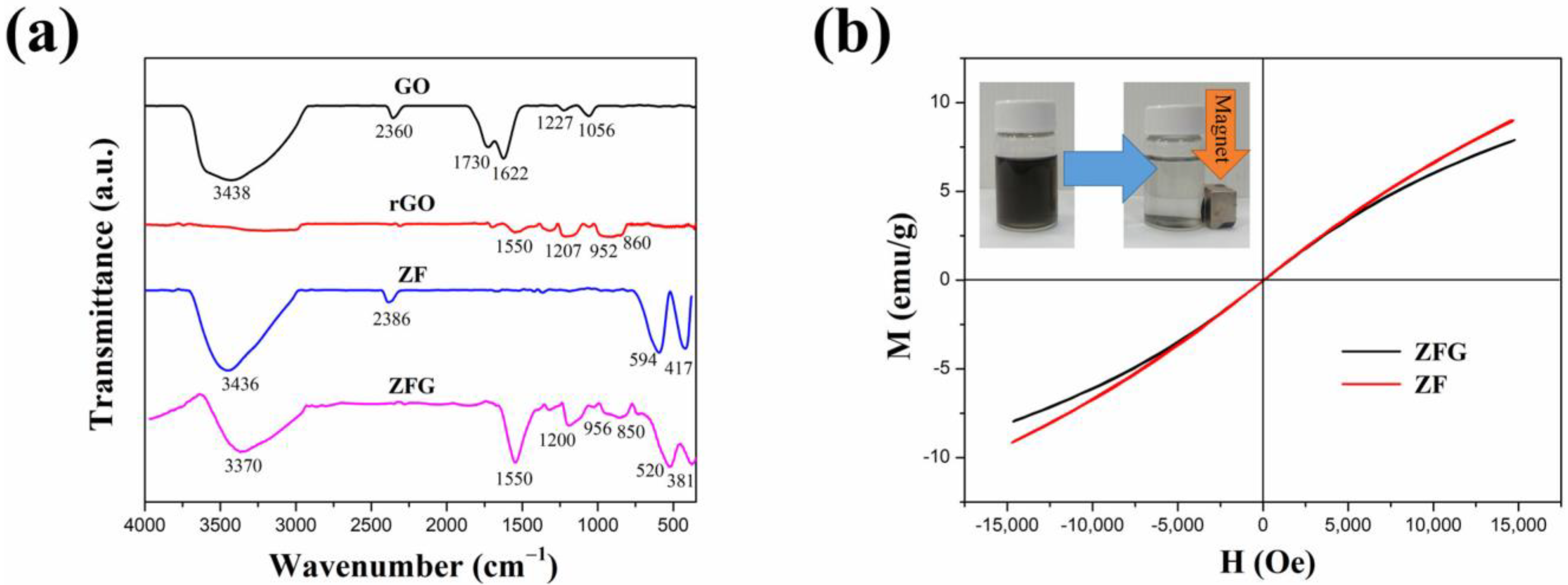



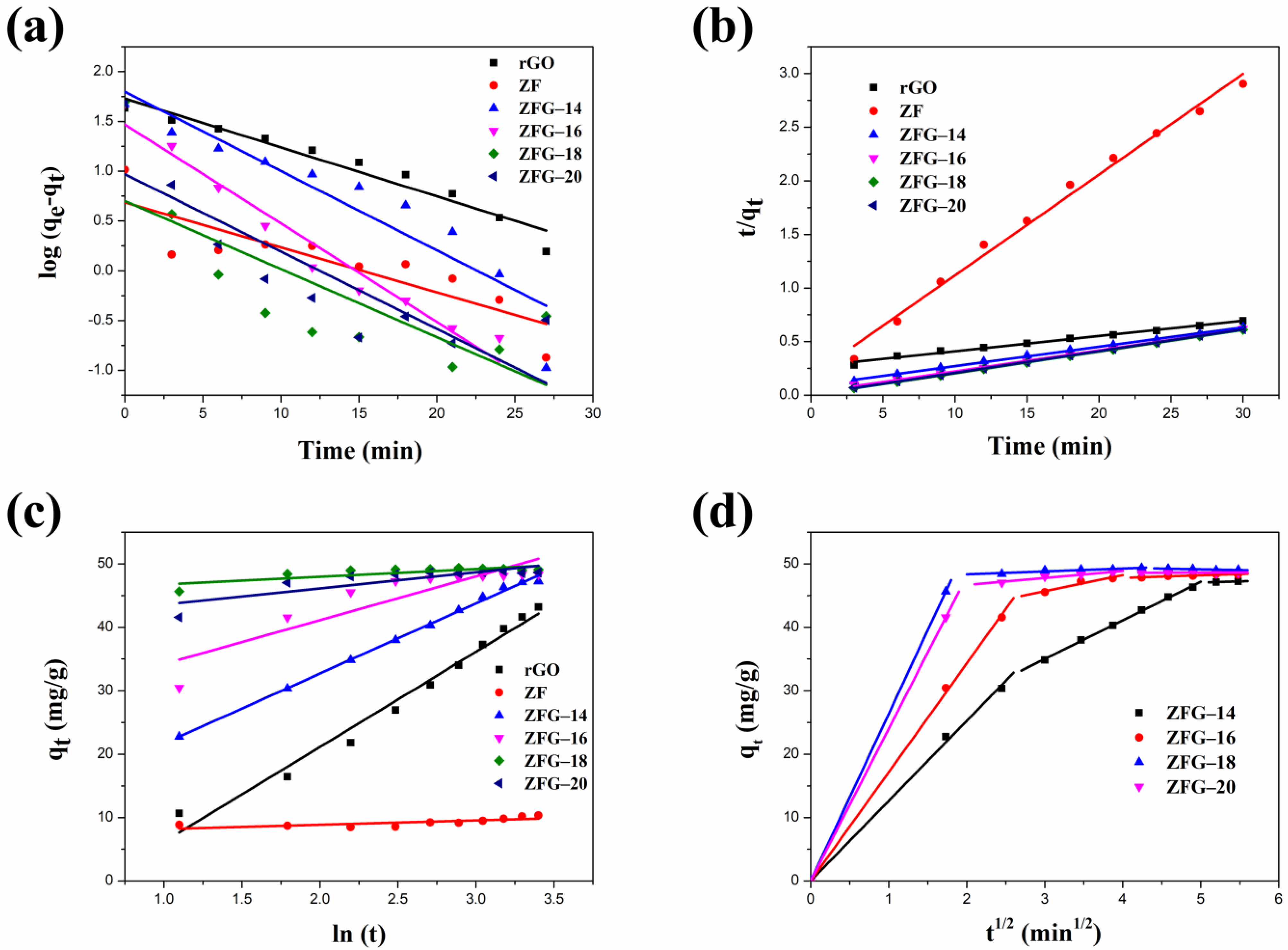
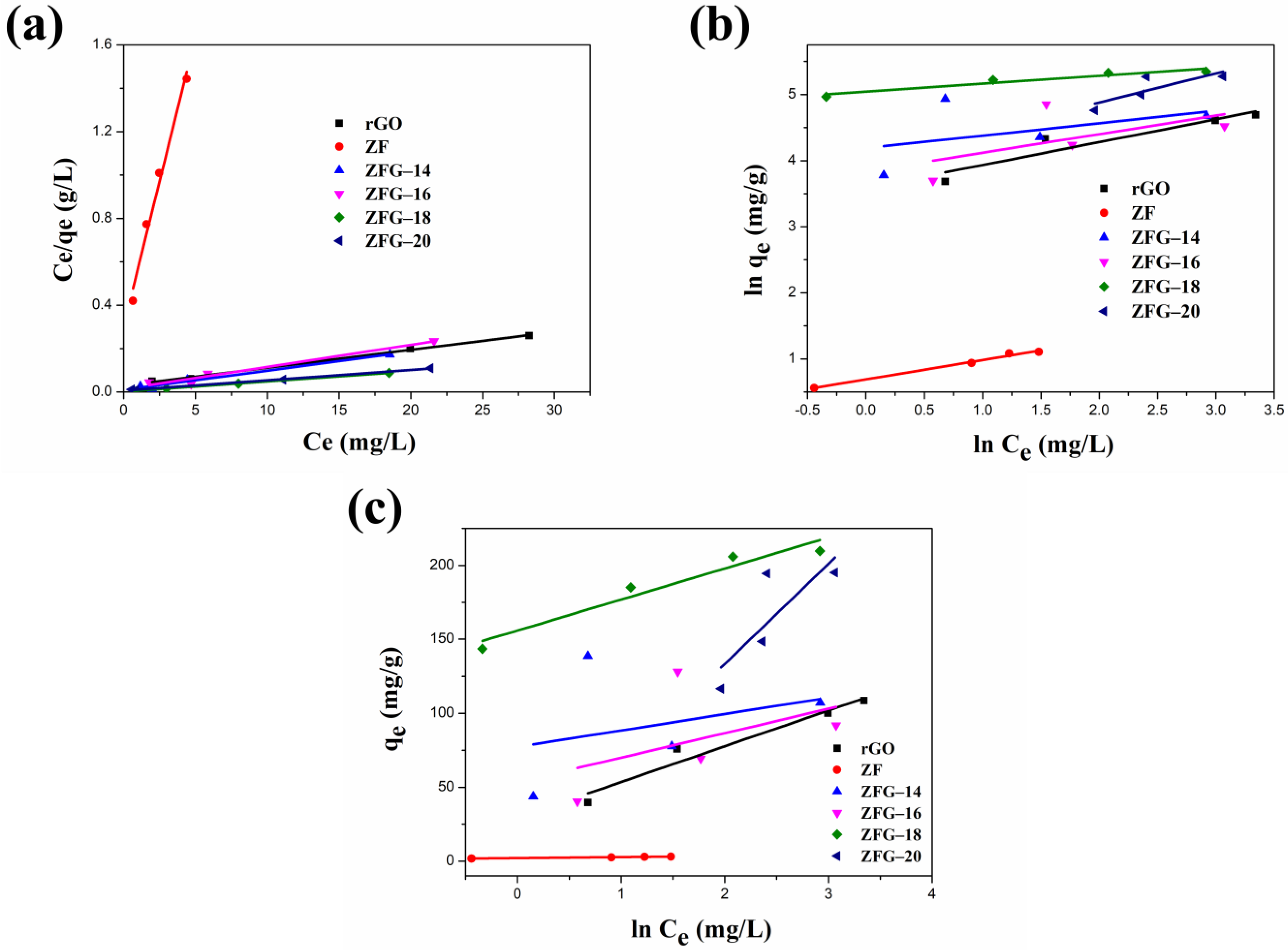
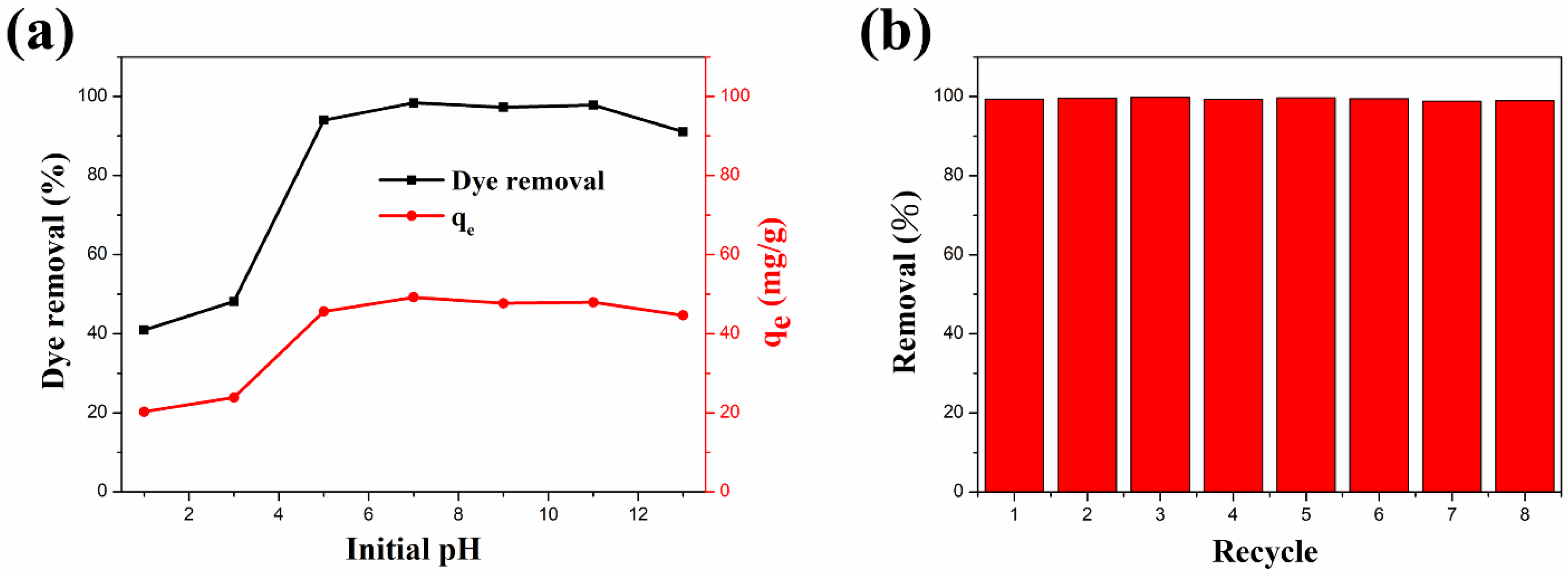
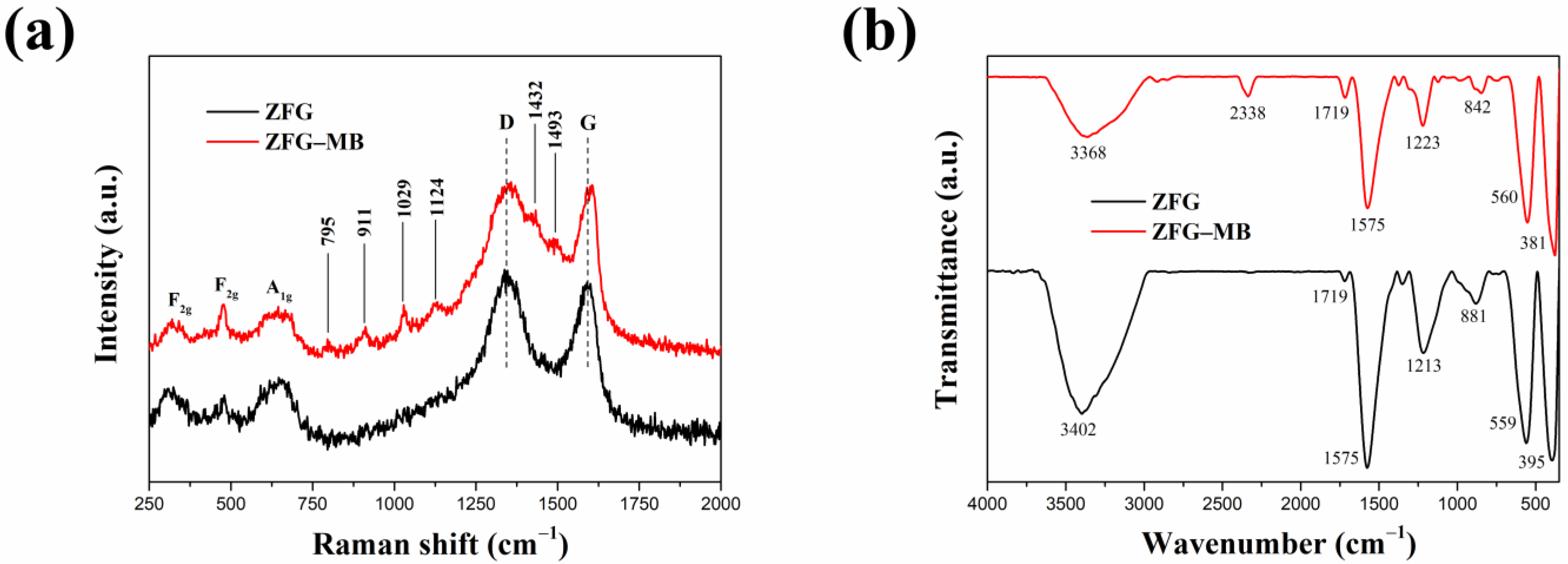
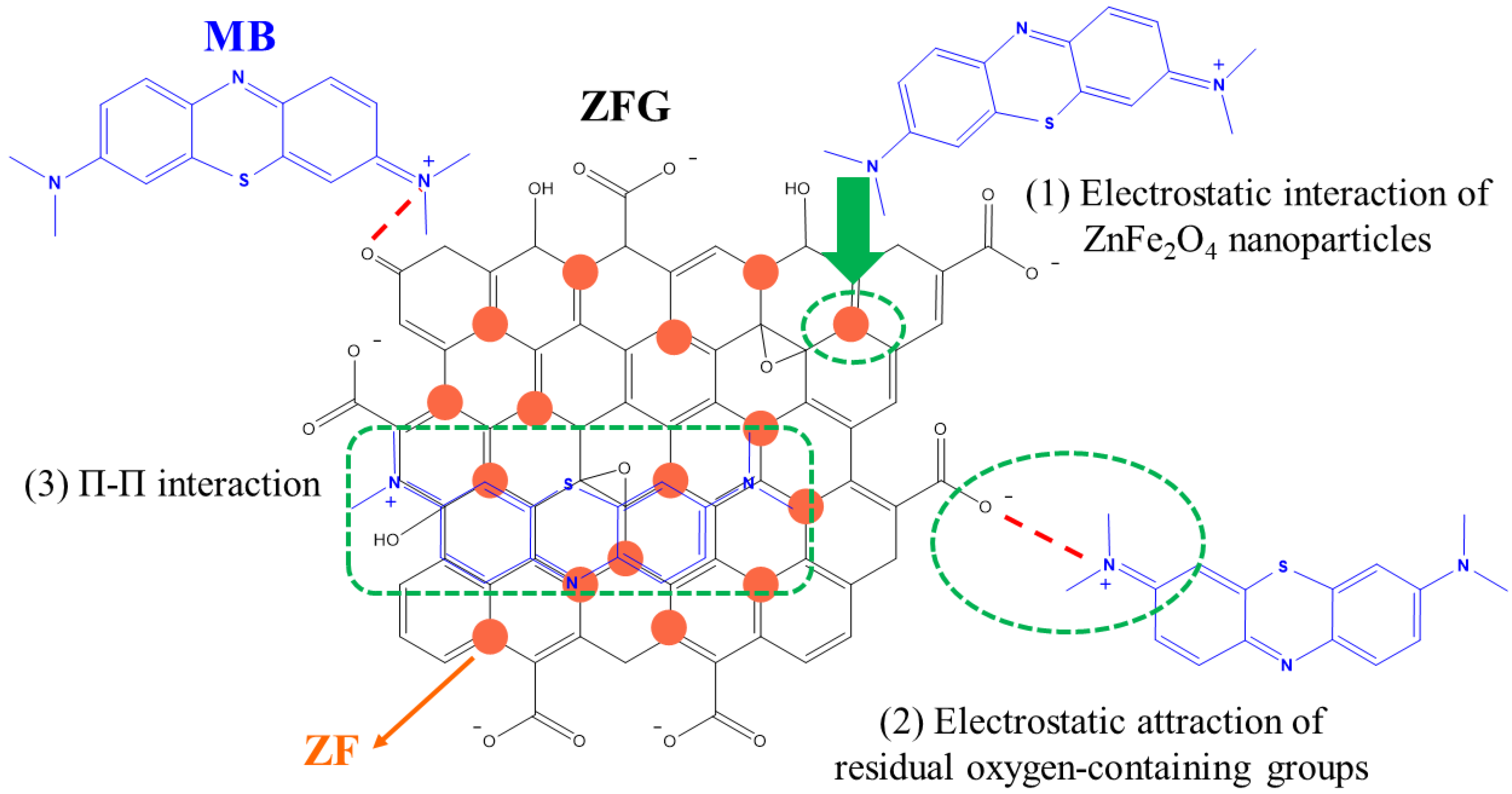
| Sample | D Band (cm−1) | G Band (cm−1) | ID/IG |
|---|---|---|---|
| GO | 1361 | 1605 | 0.99 |
| rGO | 1346 | 1577 | 1.03 |
| ZFG-14 | 1346 | 1587 | 1.03 |
| ZFG-16 | 1343 | 1588 | 1.03 |
| ZFG-18 | 1348 | 1589 | 1.04 |
| ZFG-20 | 1344 | 1588 | 1.05 |
| Sample | Particle Size (nm) |
|---|---|
| ZF | 12.1 ± 2.7 |
| ZFG-14 | 10.6 ± 2.0 |
| ZFG-16 | 10.0 ± 1.9 |
| ZFG-18 | 8.1 ± 1.8 |
| ZFG-20 | 9.3 ± 1.8 |
| Sample | qe (mg g−1) | Removal (%) |
|---|---|---|
| rGO | 43.06 ± 0.13 | 86.12 ± 0.27 |
| ZF | 9.49 ± 0.79 | 18.98 ± 1.57 |
| ZFG-14 | 47.21 ± 0.04 | 96.31 ± 0.07 |
| ZFG-16 | 48.32 ± 0.01 | 98.57 ± 0.03 |
| ZFG-18 | 49.06 ± 0.02 | 98.13 ± 0.04 |
| ZFG-20 | 48.63 ± 0.02 | 98.24 ± 0.03 |
| Models | Parameters | Sample | |||||
|---|---|---|---|---|---|---|---|
| rGO | ZF | ZFG-14 | ZFG-16 | ZFG-18 | ZFG-20 | ||
| Pseudo-first-order | qe (mg g−1) | 53.70 | 4.87 | 62.88 | 29.40 | 5.03 | 3.73 |
| k1 (min−1) | 1.13 × 10−1 | 1.04 × 10−1 | 1.83 × 10−1 | 2.28 × 10−1 | 1.58 × 10−1 | 1.28 × 10−1 | |
| R2 | 0.9505 | 0.7489 | 0.8743 | 0.9603 | 0.5975 | 0.6833 | |
| Pseudo-second-order | qe (mg g−1) | 69.93 | 10.65 | 55.24 | 51.02 | 49.26 | 49.26 |
| k2 (g mg−1 min−1) | 2.15 × 10−3 | 4.93 × 10−2 | 3.62 × 10−3 | 1.47 × 10−2 | 1.87 × 10−1 | 6.24 × 10−2 | |
| R2 | 0.9909 | 0.9916 | 0.9980 | 0.9987 | 0.9999 | 0.9998 | |
| Elovich | α (g mg−1 min−1) | 8.31 | 3.86 × 104 | 28.99 | 357.46 | 1.96 × 1016 | 2.47 × 107 |
| β (g mg−1) | 6.68 × 10−2 | 1.46 | 9.06 × 10−2 | 1.45 × 10−1 | 0.8195 | 3.92 × 10−1 | |
| R2 | 0.9790 | 0.5788 | 0.9972 | 0.8112 | 0.6572 | 0.7152 | |
| Models | Parameters | Sample | |||||
|---|---|---|---|---|---|---|---|
| rGO | ZF | ZFG-14 | ZFG-16 | ZFG-18 | ZFG-20 | ||
| Langmuir | qm (mg g−1) | 120.48 | 3.49 | 113.64 | 98.04 | 212.77 | 208.33 |
| KL (L mg−1) | 2.83 × 10−1 | 1.40 | 8.71 × 10−1 | 7.45 × 10−1 | 2.61 | 7.62 × 10−1 | |
| RL | 5.56 × 10−2 ~ 2.61 × 10−1 | 1.25 × 10−1 ~ 4.16 × 10−1 | 1.88 × 10−2 ~ 1.03 × 10−1 | 2.19 × 10−2 ~ 1.18 × 10−1 | 6.30 × 10−3 ~ 3.69 × 10−2 | 2.14 × 10−2 ~ 1.16 × 10−1 | |
| R2 | 0.9971 | 0.9930 | 0.9824 | 0.9652 | 0.9999 | 0.9977 | |
| Freundlich | n (mg−1) | 2.89 | 3.42 | 5.32 | 3.57 | 8.34 | 2.27 |
| KF (mg g−1) | 36.14 | 2.00 | 65.95 | 46.43 | 154.93 | 54.51 | |
| R2 | 0.8926 | 0.9903 | 0.2071 | 0.3469 | 0.9241 | 0.6586 | |
| Temkin | AT (L g−1) | 3.36 | 20.52 | 1091.80 | 25.32 | 1662.03 | 0.96 |
| B (kJ mol−1) | 24.22 | 6.74 × 10−1 | 11.12 | 16.56 | 21.02 | 67.87 | |
| R2 | 0.9549 | 0.9825 | 0.1089 | 0.2122 | 0.9411 | 0.6532 | |
| Adsorbents | Adsorption Capacity, qmax (mg g−1) | References |
|---|---|---|
| ZFG-18 | 212.77 | This work |
| Activated carbon | 2.57 | [13] |
| AC-MnFe2O4 | 77.44 | [14] |
| Zerolit DMF exchange resin | 24.75 | [18] |
| CoFe2O4/GO | 156.74 | [27] |
| GO-Fe3O4@P4VP | 164.20 | [29] |
| rGO-Fe2O3-Fe3O4 | 72.8 | [31] |
| ZnO/ZnFe2O4 | 37.272 | [101] |
| ZnAl/DS LDH | 113 | [102] |
| Epichlorohydrin crosslinked chitosan/carbon–clay | 86.08 | [103] |
| Graphene | 153.85 | [104] |
| Modified lychee seeds | 124.5 | [105] |
| Activated Carbon-clay | 178.65 | [106] |
| Fe3O4/kaolinite nanocomposite | 42.3 | [107] |
| TiO2-PVA | 138.888 | [108] |
| Gl-crosslinked PVA/VC-MWCNTs composite | 16.844 | [109] |
Publisher’s Note: MDPI stays neutral with regard to jurisdictional claims in published maps and institutional affiliations. |
© 2021 by the authors. Licensee MDPI, Basel, Switzerland. This article is an open access article distributed under the terms and conditions of the Creative Commons Attribution (CC BY) license (https://creativecommons.org/licenses/by/4.0/).
Share and Cite
Wang, E.-R.; Shih, K.-Y. Facile Microwave Hydrothermal Synthesis of ZnFe2O4/rGO Nanocomposites and Their Ultra-Fast Adsorption of Methylene Blue Dye. Materials 2021, 14, 5394. https://doi.org/10.3390/ma14185394
Wang E-R, Shih K-Y. Facile Microwave Hydrothermal Synthesis of ZnFe2O4/rGO Nanocomposites and Their Ultra-Fast Adsorption of Methylene Blue Dye. Materials. 2021; 14(18):5394. https://doi.org/10.3390/ma14185394
Chicago/Turabian StyleWang, En-Rui, and Kun-Yauh Shih. 2021. "Facile Microwave Hydrothermal Synthesis of ZnFe2O4/rGO Nanocomposites and Their Ultra-Fast Adsorption of Methylene Blue Dye" Materials 14, no. 18: 5394. https://doi.org/10.3390/ma14185394
APA StyleWang, E.-R., & Shih, K.-Y. (2021). Facile Microwave Hydrothermal Synthesis of ZnFe2O4/rGO Nanocomposites and Their Ultra-Fast Adsorption of Methylene Blue Dye. Materials, 14(18), 5394. https://doi.org/10.3390/ma14185394





